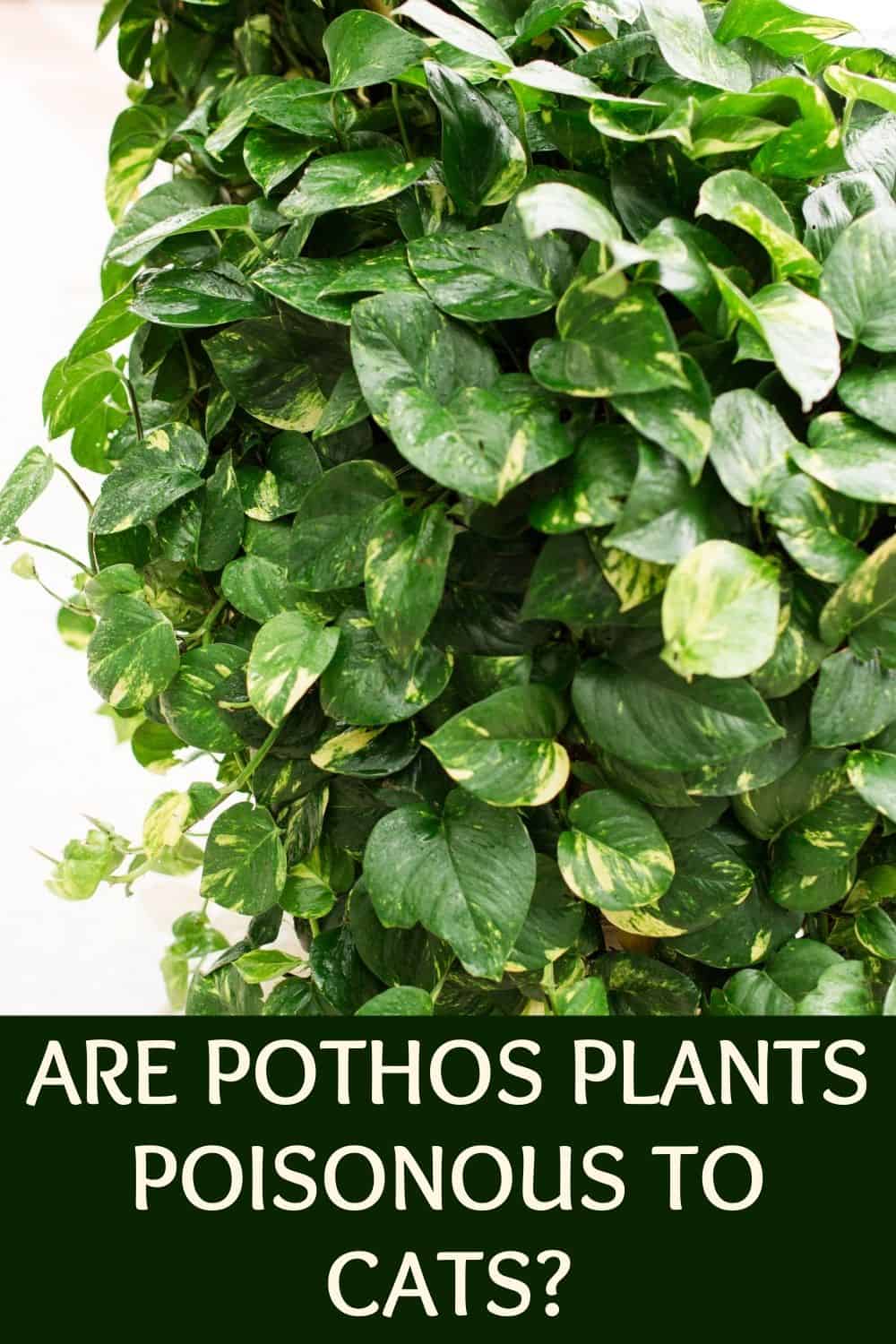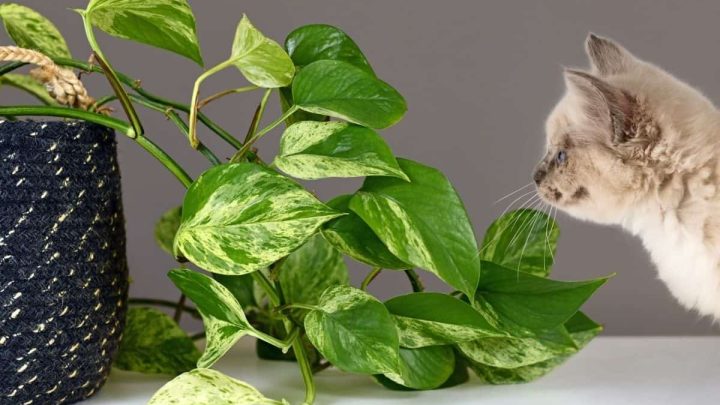Pothos are popular with indoor gardeners for their hardiness and low light and water requirements. They are attractive trailing plants known for their air-purifying abilities that come in several varieties and usually have variegated leaves. Cat-loving indoor gardeners at this point will be saying, “Yes, but are pothos plants poisonous to cats?”.
All pothos plants are poisonous to cats. However, the leaves and stems must be chewed on or eaten before they are harmful. The poison they contain is not deadly and won’t harm pets just brushing past it, but chewing on it can cause drooling, vomiting, mouth irritation, and decreased appetite in cats.
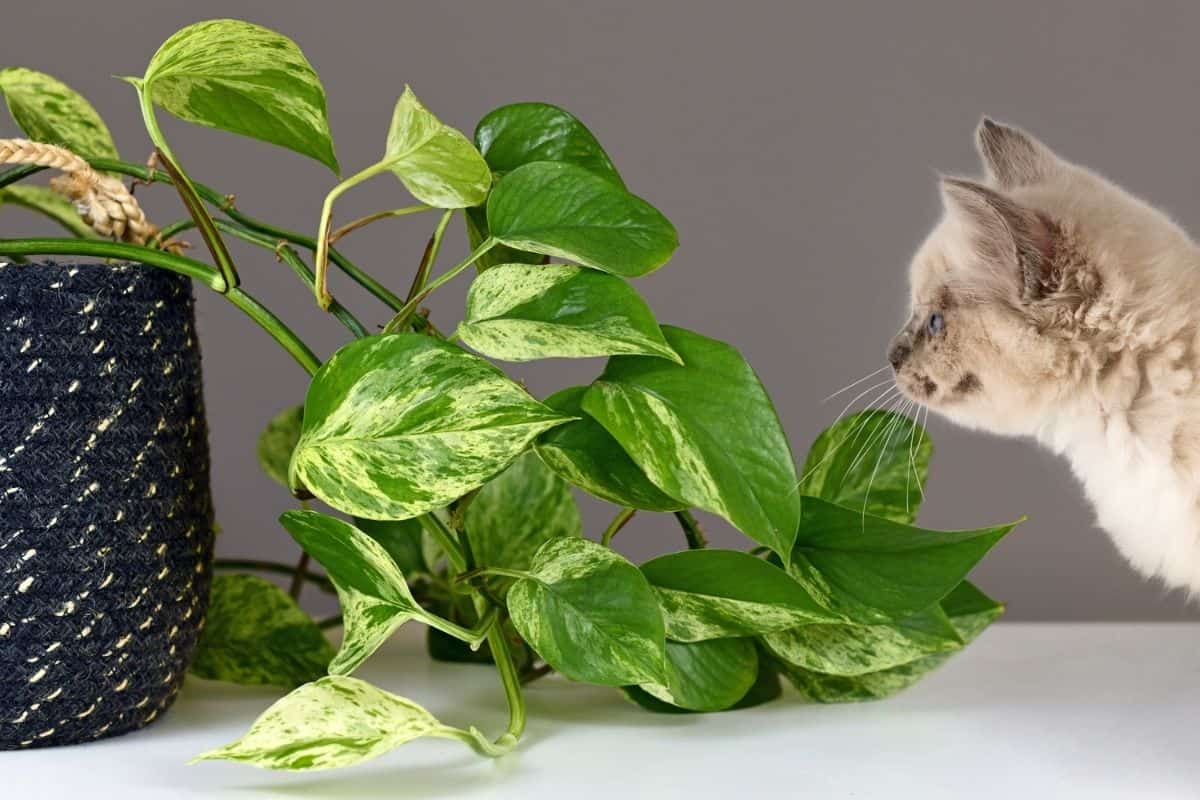
Pothos is a common name for plants known by the scientific name Epipremnum, although, just to confuse matters, the name pothos is sometimes used for Scindapsus too. Technically, they are two different plant genera belonging to the aroid family, but the differences are so slight from the layman’s perspective that they are negligible. The most common pothos is the Golden Pothos, Epipremnum aureum, also known as Devil’s Ivy or taro vine.
These plants are very popular because they are so easy to care for, are very tolerant of different light and watering needs, and they look beautiful when they trail or vine in a room. However, if you have cats, beware.
Keeping Your Cats Safe from Toxic Plants
As a pet parent, you have an obligation to keep your pets safe from toxic plants. However, some cats are drawn to plants and want to eat them, dig in their soil, or play with them. Plants that are toxic to cats can cause a variety of issues from oral irritation to liver failure or kidney failure and even death in extreme cases. The only way to truly prevent an accident like this is to prevent your cat from gaining access to the plants, or just not keeping poisonous plants like this in your home at all.
Pothos is a popular houseplant that also happens to be very toxic to cats. Similar to snake plants and peace lily, these common plants can cause harm to your beloved pet and many owners don’t even realize it until it’s too late. This poisonous plant comes in several varieties, so it’s important to learn how to identify it if you have cats.
Pothos Varieties
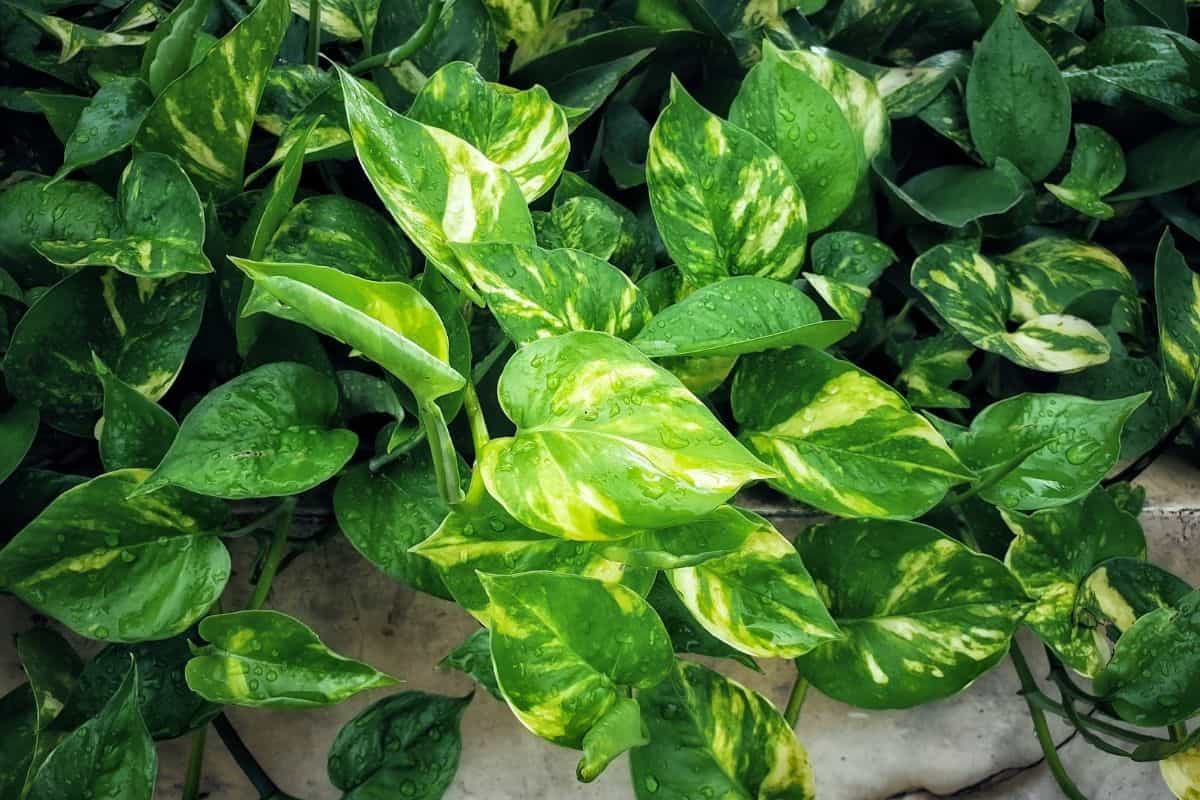
You should know your pothos varieties to be able to ascertain whether your potted plant poses a risk to your favorite feline. When buying new house plants, you can easily see what they are from the nursery labels, but if you have recently acquired a kitty and already have some plant friends at home, it may be wise to do an inventory.
Many plants are toxic to cats. This indoor plant is one to add to the list. And it’s important to learn how to spot it and to identify if you may already have a variety of it in your home where your cat can access it.
Apart from the Golden Pothos plant, which has yellow variegations in the leaves, other pothos varieties include:
- Neon Pothos – bright green, almost incandescent leaves;
- Marble Queen Pothos – dark green leaves shot through with creamy white;
- Manjula Pothos – heart-shaped leaves, heavily variegated with white;
- Jessenia Pothos – variegated leaves of bright, lemony green, mixed with darker green;
- Cebu Blue Pothos – Epipremnum pinnatum, which has a very unusual pale bluish-green leaf with darker green veins;
- Silver Satin Pothos – in the Scindapsus genus, with a silvery green leaf;
- Pearls and Jade Pothos – a lot of white variegation in the leaves;
- Hawaiian Pothos – which has giant leaves up to a foot long with yellow variegation.
The uninitiated could confuse pothos plants with some vining philodendrons because they look similar at first glance. However, the leaves of pothos plants are waxier and thicker than philodendron leaves which are thinner and softer. Philodendrons belong to a different genus in the aroid family but are also mildly or moderately toxic to dogs and cats.
The Poison In Pothos Plants
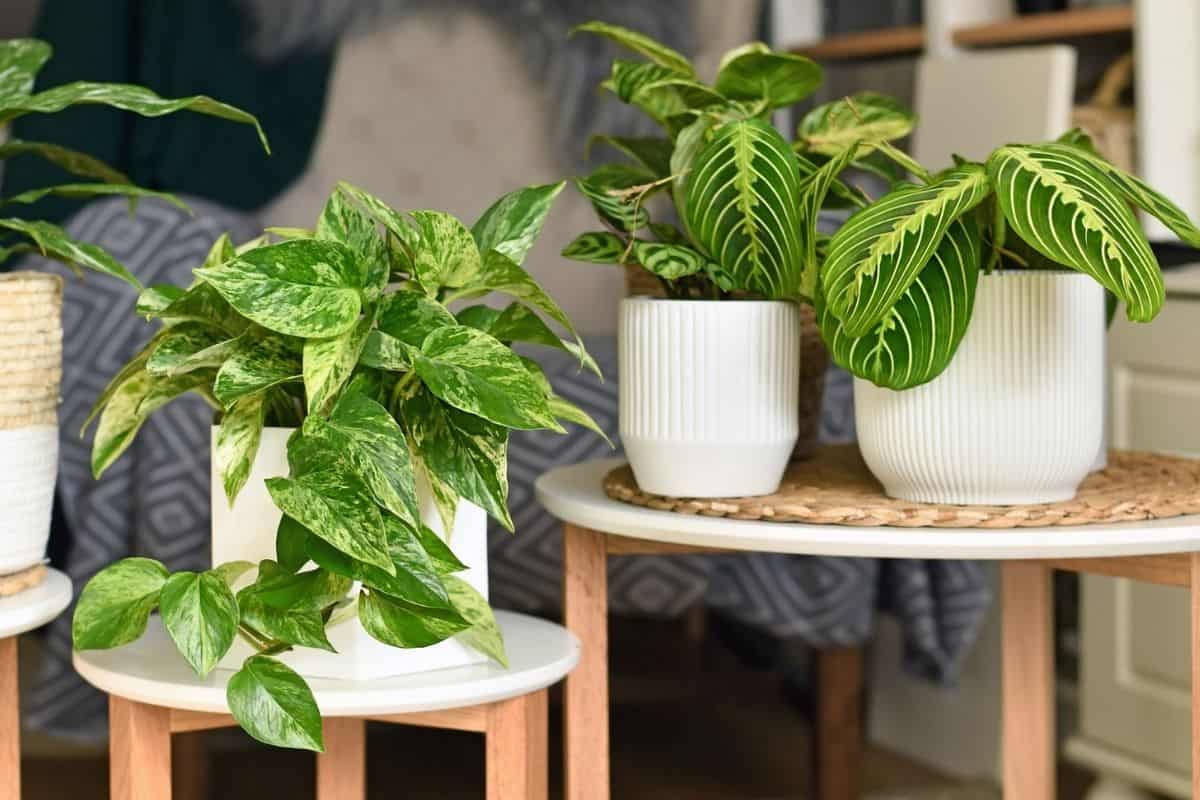
So what is it about this plant that causes it to be dangerous to cats? Several common houseplants are actually dangerous for cats but there are some specific elements of the pothos that put them in this category. Let’s take a look.
Plants in the Scindapsus genus and plants in the Epipremnum genus are toxic to cats. They both contain calcium oxalate crystals known as raphides, which are microscopically sharp and insoluble chemicals. When eaten by a cat, the tiny chemical needles stick into the mouth and throat tissues and cause an intense burning sensation. This oral irritation is one of the most common side effects.
In extreme cases, the throat can swell up so much that the cat is at risk of suffocation. Other symptoms are skin irritation, irritation of the oral mucosa, vomiting, drooling, and difficulty swallowing. If the cat is vomiting continuously, there is also a risk of dehydration.
Fortunately, pothos plants are unpleasant to the taste because they burn the lips and tongue and cats rarely ingest enough of the plant to cause severe illness. Still, it is not worth taking chances. You definitely want to keep your cat from accessing your pothos.
What to do if your cat eats some of the plants
The plant can cause significant discomfort and stress to a cat, though, so if you suspect that it has been chewing on your pothos, take it to the vet immediately. Treatment will usually involve rinsing as much of the calcium oxalate out of the mouth as possible.
If the vet suspects the cat has ingested parts of the plant, gastric lavage, i.e., rinsing out the stomach, may also be necessary.
Your cat’s mouth discomfort can be eased by giving it yogurt or cottage cheese to eat, but it may not have an appetite. If the cat is vomiting too much, the vet may also administer fluids intravenously to keep it hydrated and give it medicine to protect the stomach lining and stop the vomiting.
An overnight stay at the vet may be necessary if the cat has difficulty breathing or is too dehydrated.
Getting your cat to the vet immediately, even if that means an after-hours emergency vet, is the best option if you suspect potential poisoning of any kind.
Not surprisingly, the vet bills can quickly mount up, depending on the severity of the case, so it is recommended to keep your pothos out of your cat’s reach or keep your cat away from the plant. Prevention is always the best medicine!
How To Keep Pothos If You Have Cats
Cat behavioral experts will tell you that cats come in two primary varieties: bush dwellers and tree-dwellers. The latter like to move around at heights above the floor and have no trouble getting to the tops of fridges, cupboards, curtain rails, and bookshelves. They feel more secure in high places.
If your cat is a tree dweller, putting your pothos on a high shelf won’t necessarily keep it out of reach. If your cat is a bush dweller, you may be able to get away with keeping your pothos on top of a tall bookshelf or cupboard. The bush dwellers like to sun themselves in cozy corners lower down and spend their time under tables and beds or inside boxes.
Pothos are trailing plants that look good in hanging baskets, so if your cat is a tree dweller, you should consider using these in strategic places that the cat can’t reach. Distract your cat from your plants by providing cat trees, climbing posts, and wall shelves as perches in places where you don’t keep the pothos.
Since many cats love to watch the neighborhood goings-on from windowsills, don’t put your pothos on a windowsill. Pothos plants don’t like direct sunlight anyway. The top of the refrigerator is a magnet to some cats, so this is also not a good location for your pothos.
You can establish whether your adult cat is a tree dweller or a bush dweller just by observing its behavior. If it is a newly acquired kitten, then all bets are off until you’ve lived with it for a while. If your home is large enough, you can confine your pothos to rooms or areas that your cat cannot enter.
Are Pothos Plants Poisonous To Cats? – Conclusion
Cats and pothos plants are best kept apart at all times to ensure both of them are safe. Distract your cat by providing more attractive perches to sit on and put your pothos in a hanging basket it can’t reach. Some people have created cages for their plants, or they use them only in rooms that the cat 100% has no access to. There are many workarounds if you want to keep both your favorite plants and your cat, but it’s important to take precautions. If your cat chews on a pothos plant and is showing signs of distress, take it to the vet immediately.
Do you have any tips for keeping your plants and your cats safe to co-exist together that you’d like to share with us? We’d love to hear about it in the comments.
